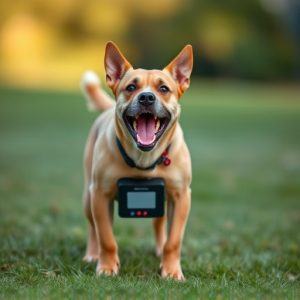Ultrasonic Pet Training: Safe, Effective Dog Deterrent Solution
Opting for humane training methods, like an Effective Distance Electronic Dog Deterrent, is crucial…….
Opting for humane training methods, like an Effective Distance Electronic Dog Deterrent, is crucial for well-behaved pets. This device emits ultrasonic sounds (inaudible to humans) within a 5-7 meter range to discourage unwanted behaviors, fostering positive reinforcement without fear or aggression. Unlike traditional deterrents, it operates from a distance, offering convenience and safety. The technology avoids negative reinforcement, making it effective for basic commands, preventing aggression, and maintaining a trusting relationship between pet and owner.
“Discover a revolutionary approach to pet training with ultrasonic pet training safety devices, offering a humane and effective solution for managing your pet’s behavior. This article explores why traditional training methods may not always be suitable and introduces the concept of electronic dog deterrents as an alternative. We’ll delve into how these devices work, their numerous benefits, and critical considerations like ensuring the effective distance of sound waves to maintain your pet’s safety while encouraging desired actions.”
- Understanding the Need for Safe Pet Training Methods
- How Ultrasonic Devices Work as Electronic Dog Deterrents
- Benefits of Using an Ultrasonic Pet Training Safety Device
- Ensuring Effective Distance and Safety Measures
Understanding the Need for Safe Pet Training Methods
In the pursuit of well-behaved pets, it’s crucial to embrace training methods that prioritize safety and humaneness. Traditional training techniques often rely on punishments or aversive stimuli, which can lead to fear, aggression, and a breakdown in trust between pet and owner. This is where an Effective Distance Electronic Dog Deterrent comes into play. By emitting ultrasonic sounds at a specific frequency, these devices offer a non-lethal, remote way to discourage unwanted behaviors without causing harm or stress.
The key advantage lies in their precision and effectiveness within a defined range. Owners can use them to redirect a dog’s attention or deter specific actions from a distance, teaching pets what behaviors are acceptable and which ones lead to the activation of this gentle deterrent. This not only promotes positive reinforcement but also ensures that training remains a safe, positive experience for both pet and owner.
How Ultrasonic Devices Work as Electronic Dog Deterrents
Ultrasonic devices operate by emitting high-frequency sound waves that are inaudible to humans but can be detected by dogs. These sounds act as a form of communication, designed to deter unwanted behaviors like barking, jumping, or biting. The device emits an ultrasonic tone when it senses movement or noise, creating an uncomfortable experience for the dog without causing any physical harm. This works effectively within an optimal range, typically between 5 to 7 meters (16 to 23 feet), known as the effective distance of an electronic dog deterrent.
The key to their success lies in the specific frequency and intensity of the sound waves. Dogs have more sensitive hearing than humans, and these ultrasonic tones are specifically tailored to trigger their discomfort without disturbing nearby people or other animals. When a dog enters this effective range, they hear the high-pitched squeal, which serves as a gentle yet powerful reminder to adjust their behavior.
Benefits of Using an Ultrasonic Pet Training Safety Device
Using an ultrasonic pet training safety device offers numerous benefits for both pet owners and their furry friends. One of its key advantages is its effectiveness over a substantial distance, making it a convenient solution for managing pets in various settings. Unlike traditional electronic dog deterrents that require direct line-of-sight contact, these devices can be activated from a good distance, allowing you to train your pet without causing them discomfort or distress.
Additionally, ultrasonic technology is known for its humane approach to pet training. It emits high-frequency sound waves that are typically inaudible to humans but irritable to dogs and cats. This method does not rely on negative reinforcement like shock collars, making it a gentler alternative. The device can be used to teach pets basic commands, prevent unwanted behaviors like jumping on furniture or barking excessively, and even manage more complex issues such as aggression without subjecting them to harmful stimuli.
Ensuring Effective Distance and Safety Measures
When it comes to an electronic dog deterrent, like an ultrasonic pet training safety device, ensuring effective distance is paramount for both its functionality and your pet’s well-being. These devices emit high-frequency sound waves that are generally inaudible to humans but irritating to dogs, encouraging them to alter their behavior. The key lies in proper placement and range; the deterrent should be positioned at a height suitable for the pet’s line of sight, typically 1–2 feet above the ground, with a range adjusted to cover just enough space without causing distress from excessive repetition.
Safety measures extend beyond distance. It’s crucial to safeguard against accidental activation by humans or other non-target animals. Look for devices with sensitivity control and customizable settings to adapt to your home environment. Additionally, regular testing ensures the device operates as intended, minimizing any potential harm or discomfort to both pets and family members.
Ultrasonic pet training safety devices offer a modern, non-violent approach to discipline, making them an excellent alternative to traditional methods. By leveraging sound waves as an electronic dog deterrent, these tools can effectively correct unwanted behaviors from a safe distance. When used responsibly and at the appropriate effective distance, ultrasonic devices provide pet owners with a reliable and humane way to train their pets, ensuring a harmonious coexistence between humans and their furry friends.


